40 Years of Audi quattro
A vehicle that was never actually planned and was eventually only released as a special edition became a great sales success and one of the most famous cars with four rings in the radiator grille. We’re talking about the Audi quattro, which was launched in 1980 and, in the following years, turned the World Rally Championship upside down. Much has been written about this vehicle in the 40 years since it was added to the street scene. Most of it should actually be true. The Audi quattro enriched the market with a completely new type of car: high-volume passenger cars with permanent four-wheel drive.
Until its debut at the Geneva Motor Show in 1980, there had only been a few small-series vehicles with this drive technology, including the Jensen Interceptor FF. In addition, some racing car manufacturers such as Bugatti and Lotus had tried their hand at the technology and of course there were already off-road vehicles available with switchable or permanent four-wheel drive. But a normal car for daily use? Who’s gonna buy something like that? There aren’t that many foresters in the world to make a profit from it. At least that was the opinion of most manufacturers until the 1970s. Audi would probably have retained this way of thinking as well, hadn’t test director Jörg Bensinger had to drive the support car during winter testing in Sweden. This car was a Volkswagen Iltis, which some German readers may still know from their time at the German army. Bensinger soon discovered that he could easily outpace the actual test vehicles on the snow and ice slopes, although the Iltis only had 55 kW/75 hp.
Bensinger saved this observation and began to ponder whether such a drivetrain could possibly do just as well in a normal passenger car. He sought to talk to the board member of Audi’s vehicle development department, a certain Ferdinand Piëch, and found him as a supporter of this project. Under his patronage, he assembled a small team of engineers and insiders around the head of pre-development, Walter Treser, and built a first prototype based on an Audi 80. Interesting detail: This prototype already had a five-cylinder engine, one of the details for which the later series car was to become famous. This car was brought to a winter test in Austria in 1978, where important decision-makers from the Volkswagen Group were to be present. They hadn’t known anything about this project before. They took it with humour and put the prototype through its paces, quickly proving that it was vastly superior to the rest of the test vehicles with conventional drive systems. When they were told that the development team was in a hurry and couldn’t get winter tyres for the four-wheel drive prototype, so all tests had been done with summer tyres (on snow!), the decision was almost certain. After further tests in the summer of ’78 it was finally decided that this drive system would go into production.
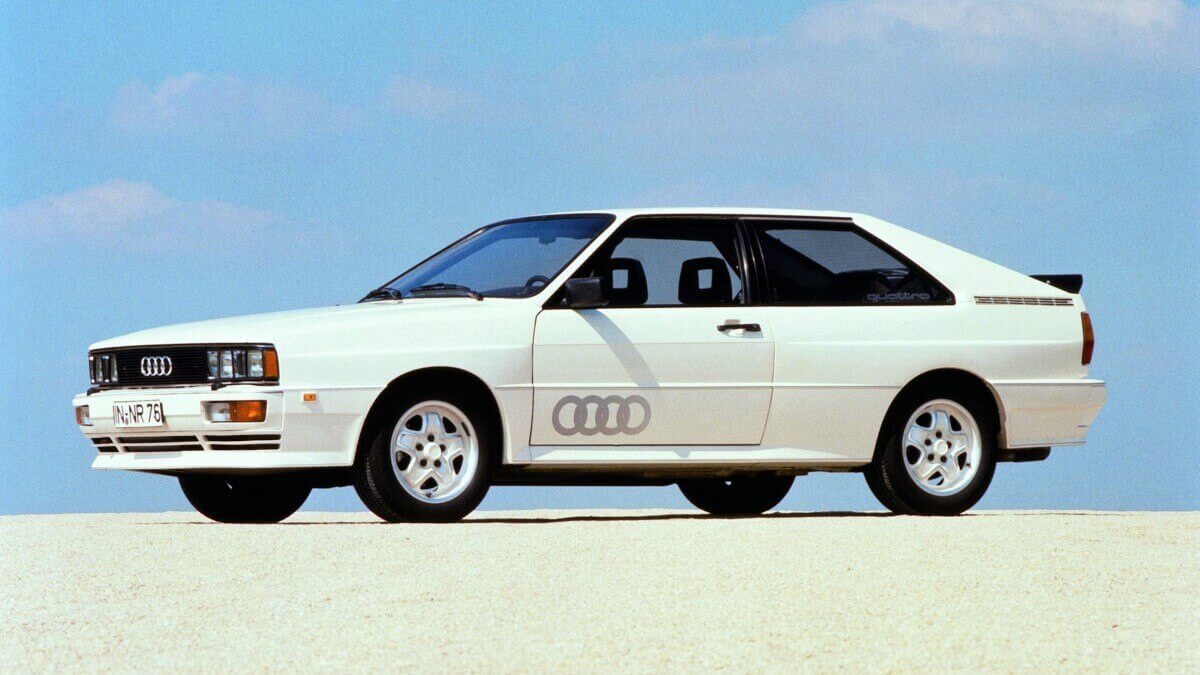



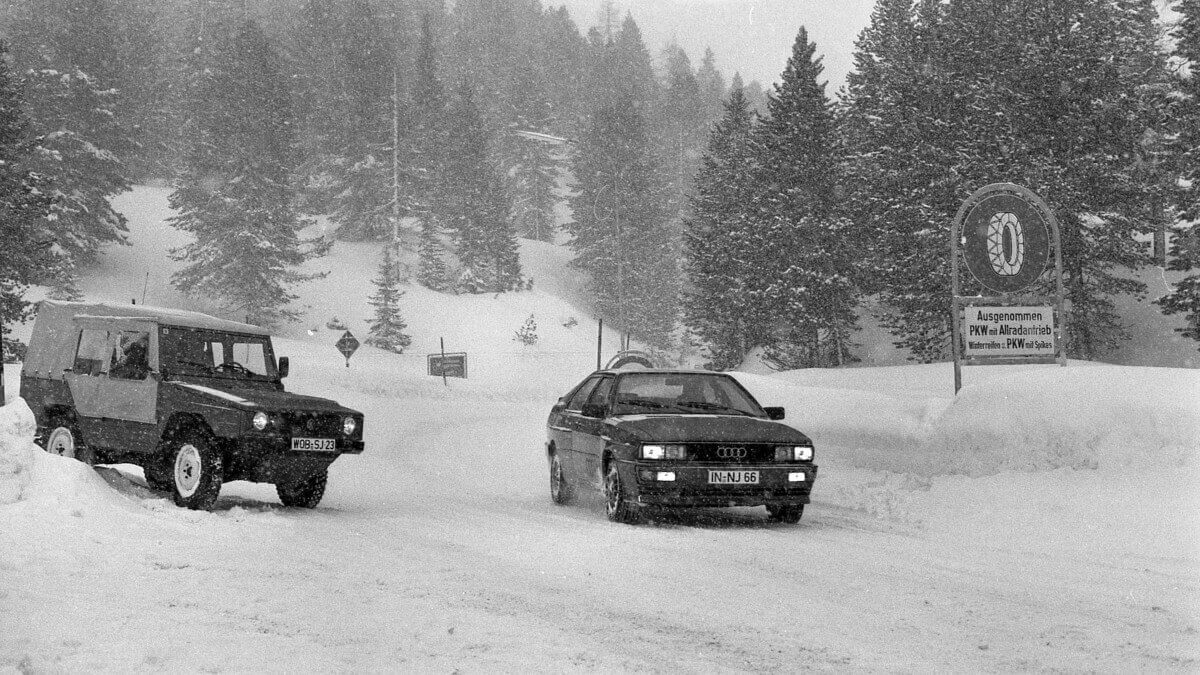



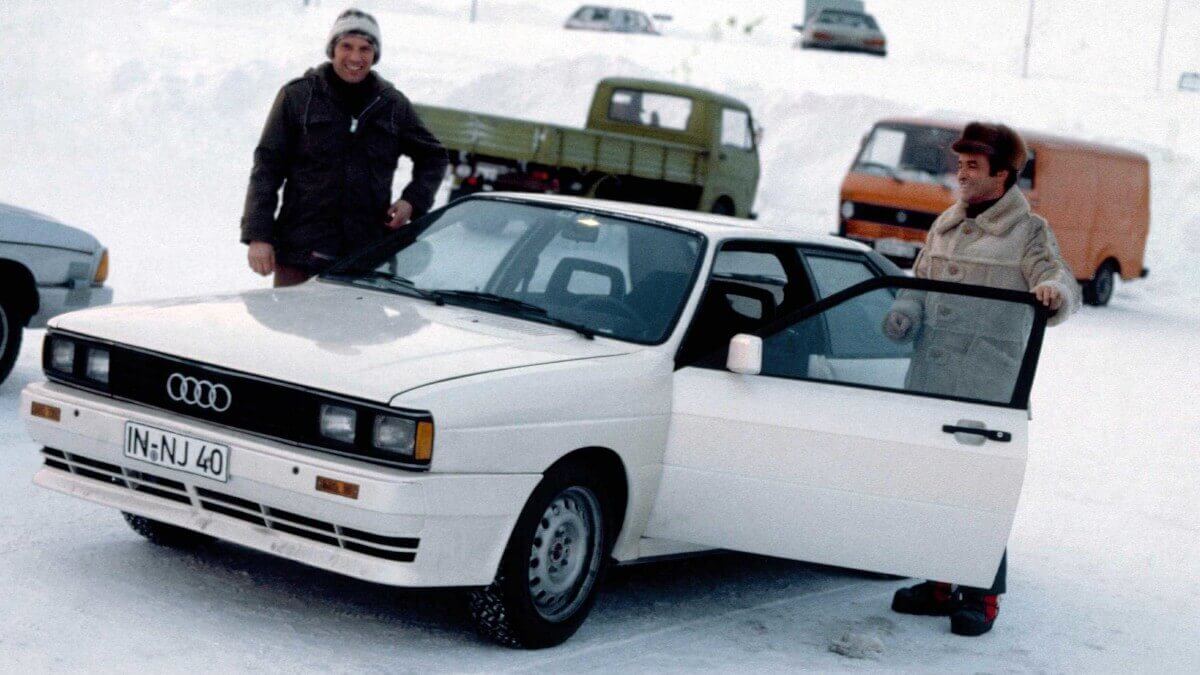



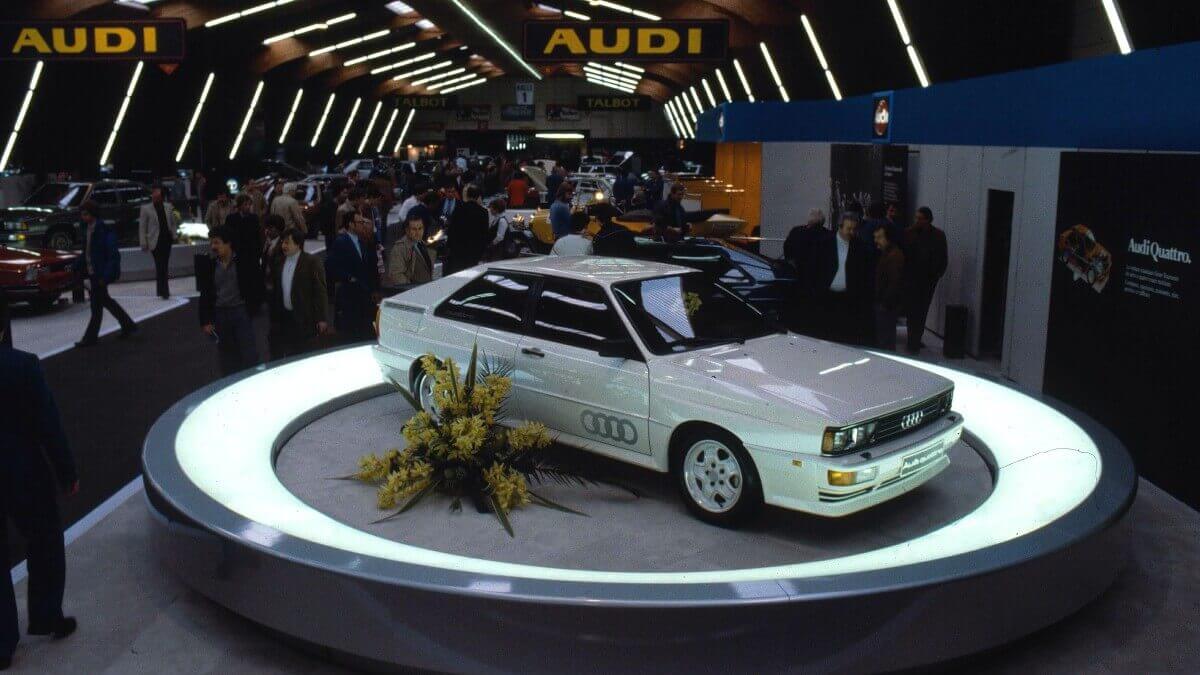



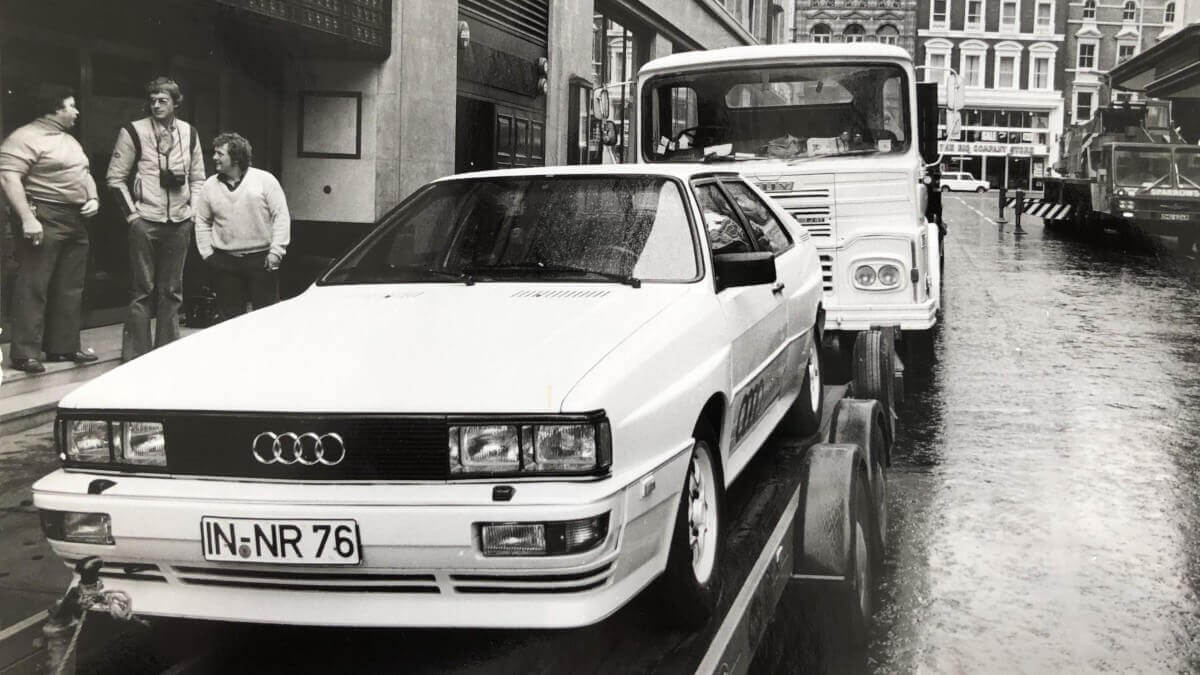



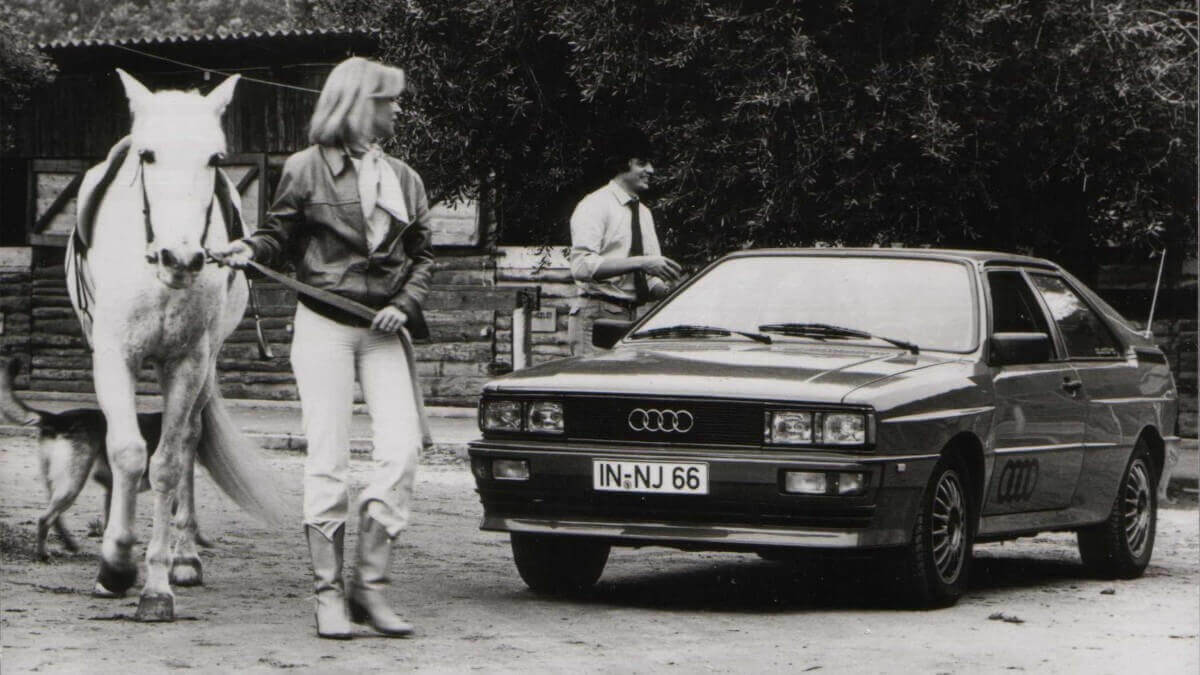



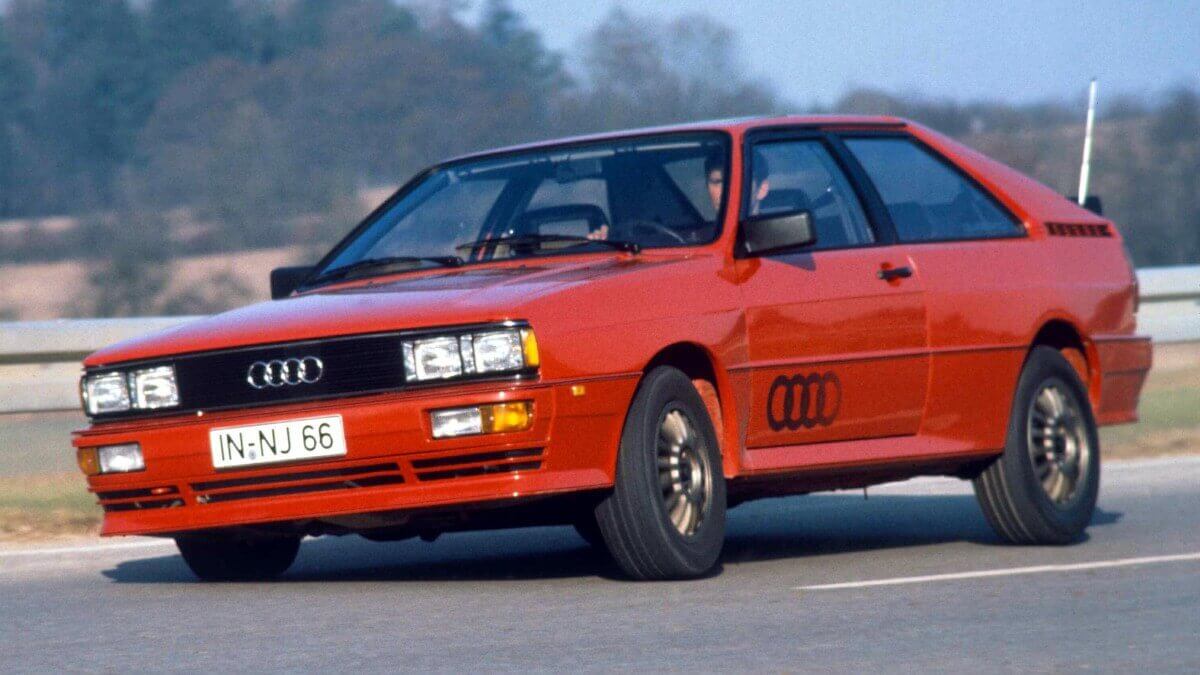



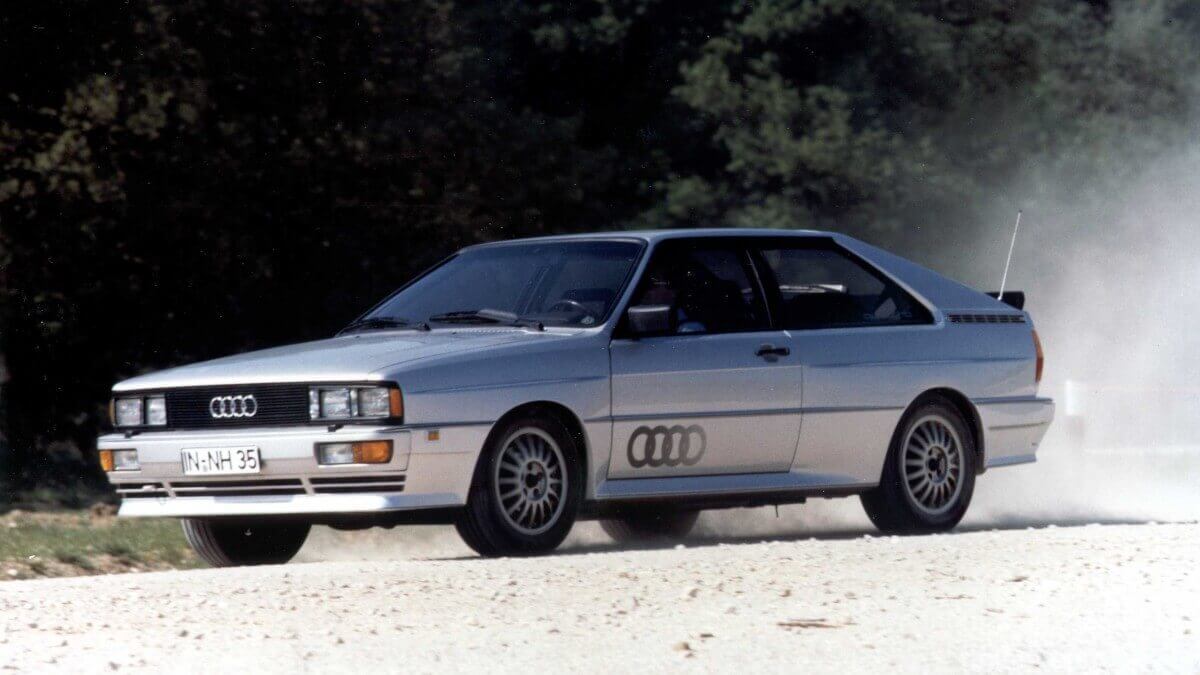



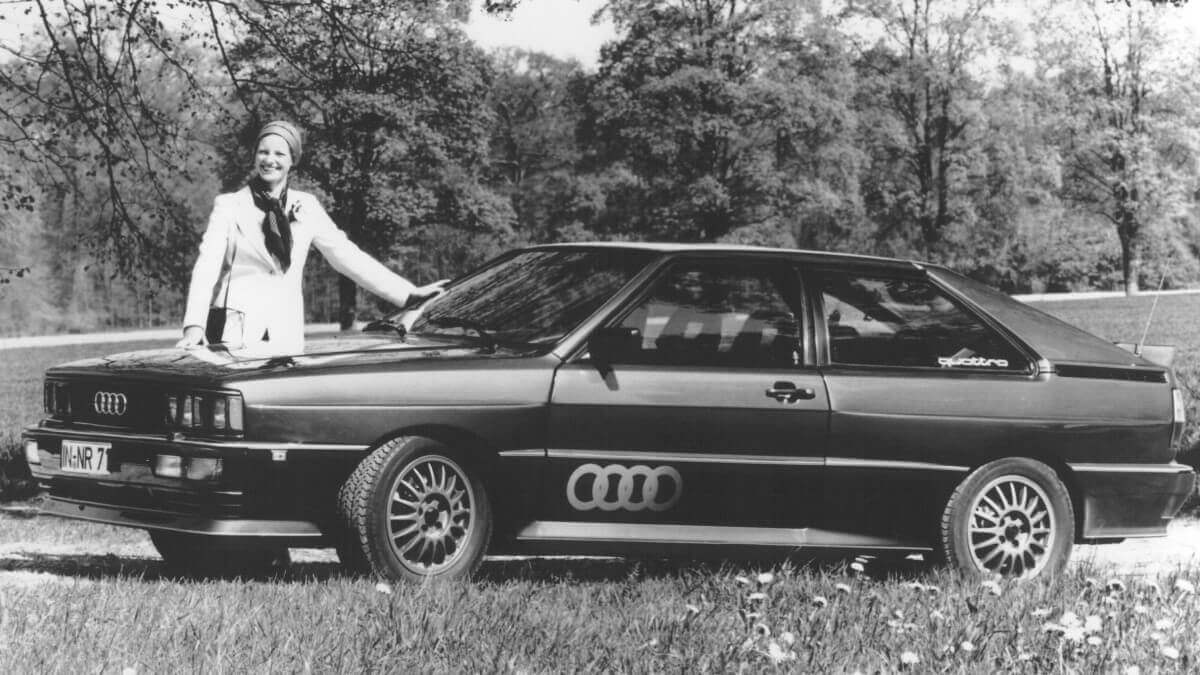



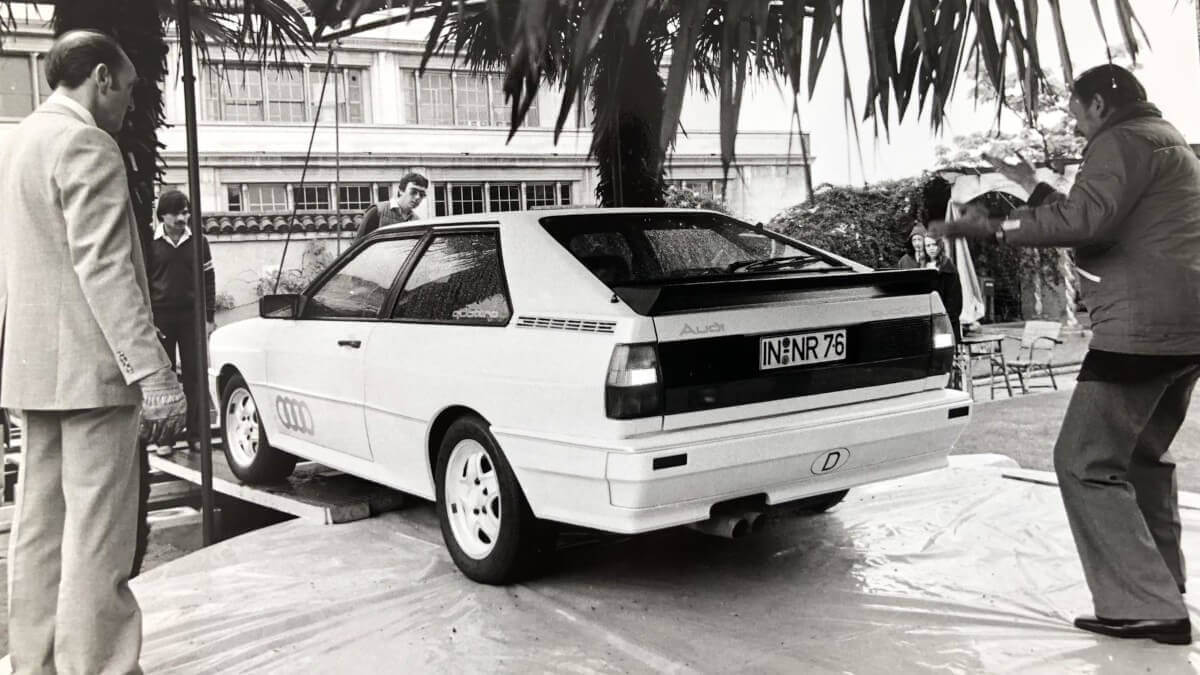



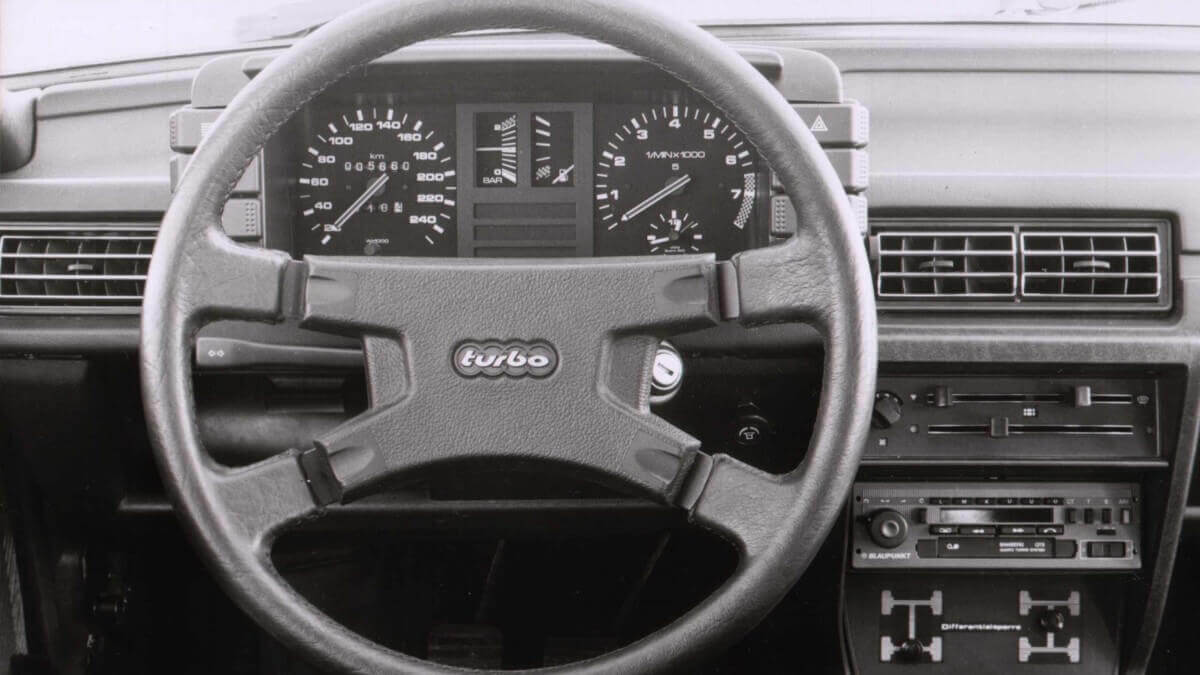



At the beginning of 1979, some members of the press were invited to come and test four different cars: two with front-engine and rear-wheel drive, an Audi with front-engine and front-wheel drive and a four-wheel drive prototype which had again been fitted with summer tyres, but the journalists weren’t informed of this until after their test drives. Once again the all-wheel drive concept was convincing in every respect. In March 1980, the finished vehicle was presented at the Geneva Motor Show. However, sales forecasts from Audi were only for a few cars, as they thought of it as a technology carrier for advertising purposes. Therefore they had taken the trouble to build an independent car with a Coupé bodywork instead of simply equipping the Audi 80 saloon or another existing model line with the new drive technology. It should be clear from the beginning that something new was arriving at the dealers. The presentation was preceded by the naming process. According to first plans the car should have been called ‘Coupé All-Rad-Antrieb Turbo’ or short ‘CARAT’. However, as there was a cheap perfume with the same name, this idea was soon discarded and the team switched to the Italian word for four, ‘quattro’. It should be noted that the name of this car is always written in lower case, as is the quattro GmbH, which was founded three years later.
The body design followed the style of the time and the then current design language of Audi. Sharp corners and edges dominate the picture. The car looks as if there was no curve ruler available in the design office, but only at first glance. If you look closely, for example, you will see deliberate curves on the fender flares, which support the overall picture excellently and give the car a powerful but not too aggressive appearance. The Audi Coupé, which was launched at the same time, had to make do without the wide fenders. This impression is continued in the interior, because here, too, predominantly angular shapes were used for the dashboard. The speedometer reaches up to 160 mph and thus already shows Audi’s new self-confidence with this car. In the center console, the driver can engage or disengage the two differential locks. Under the bonnet there were no options for the customers to choose from. Only a 2.1-liter five-cylinder with turbocharging and 147 kW/200 hp was listed in the data sheet. In 1984, a version with catalytic converter was added, which produced only 119 kW/162 hp on the four wheels with the same displacement. The quattro’s kerb weight was 1,335 kilograms. It went on sale in Germany at an entry price of DM 49,900.
In 1985, the most extensive model update – today we would call it a ‘facelift’ – appeared during the production of the Audi quattro. In addition to new one-piece headlights in combination with a redesigned radiator grille, there were also black tail lights and a newly designed dashboard. This was followed in 1987 by an engine with additional 0.1 liters as a choice for customers. Initially it came without catalytic converter and again delivered the well-known performance data of 147 kW/200 hp. Another two years later a further development of the engine with 20 valves and 162 kW/220 hp was released. In this version as Audi quattro 20V the vehicle was produced until 1991. Since the quattro had become more and more luxurious in the meantime compared to the original version, the increase of the basic price to DM 93,650 in the last model year probably surprises only few readers. A total of 11,452 Audi quattro were built for the road.
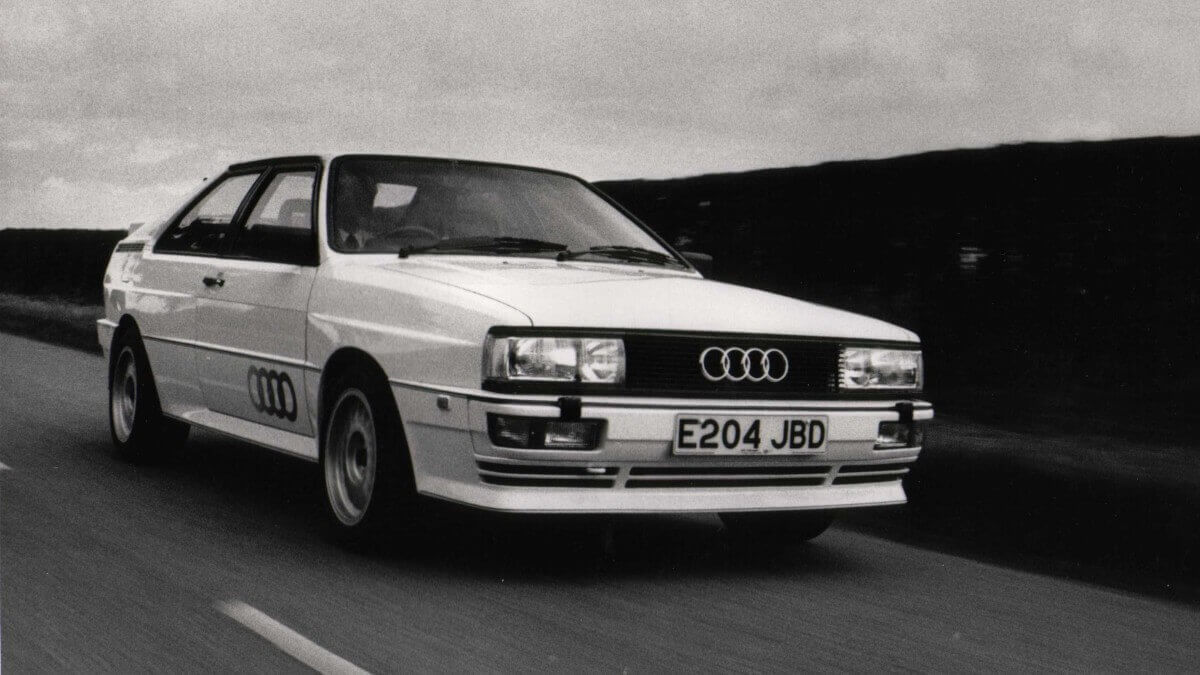



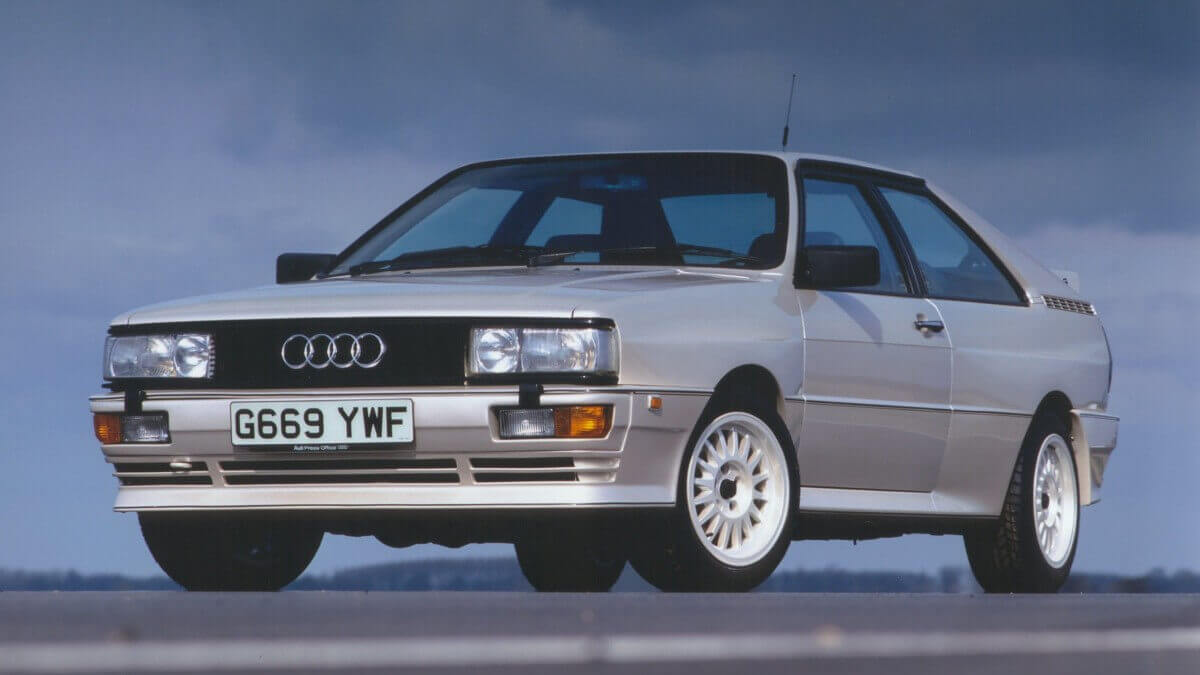



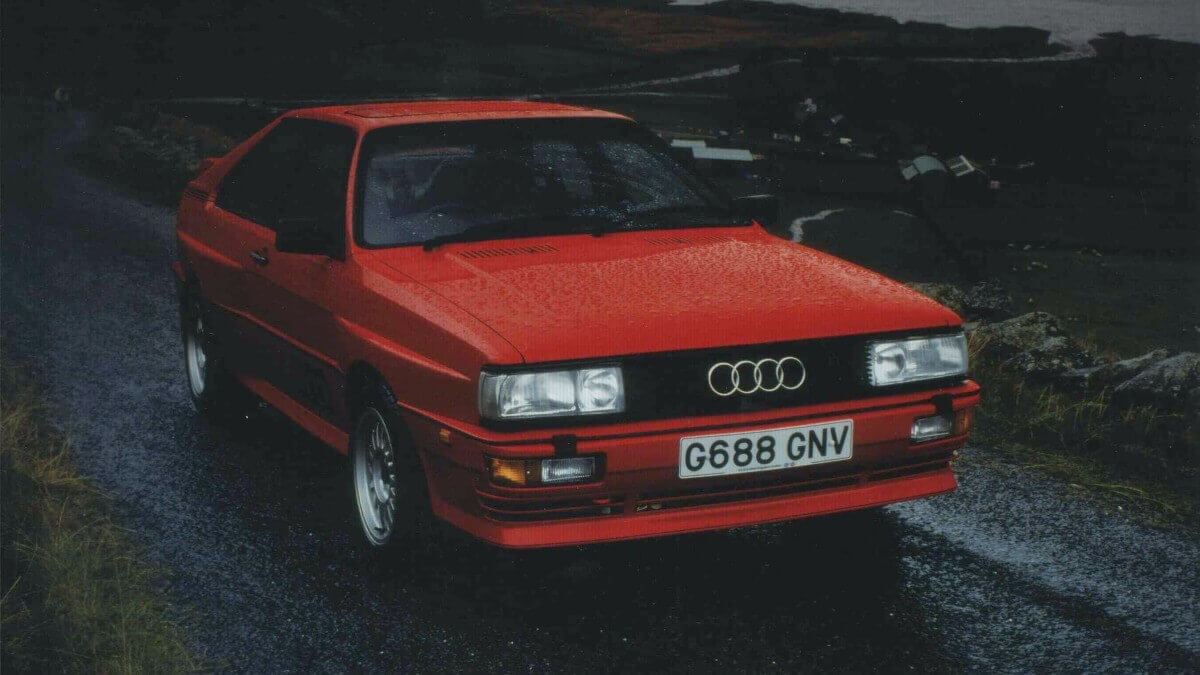



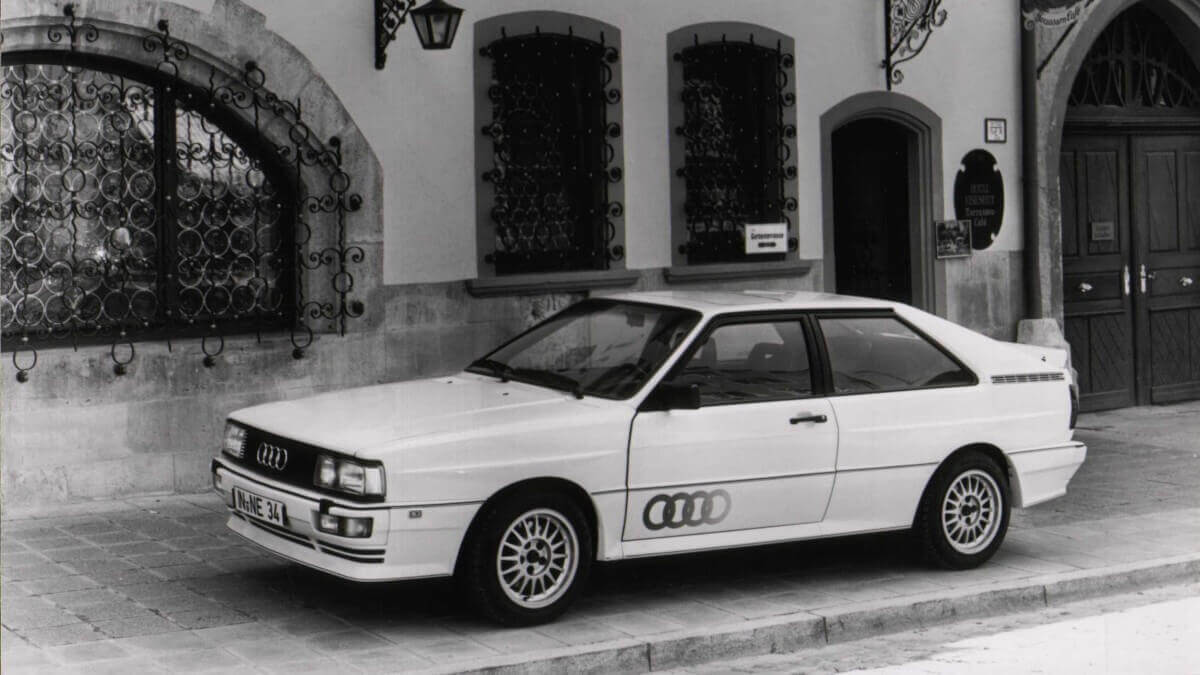



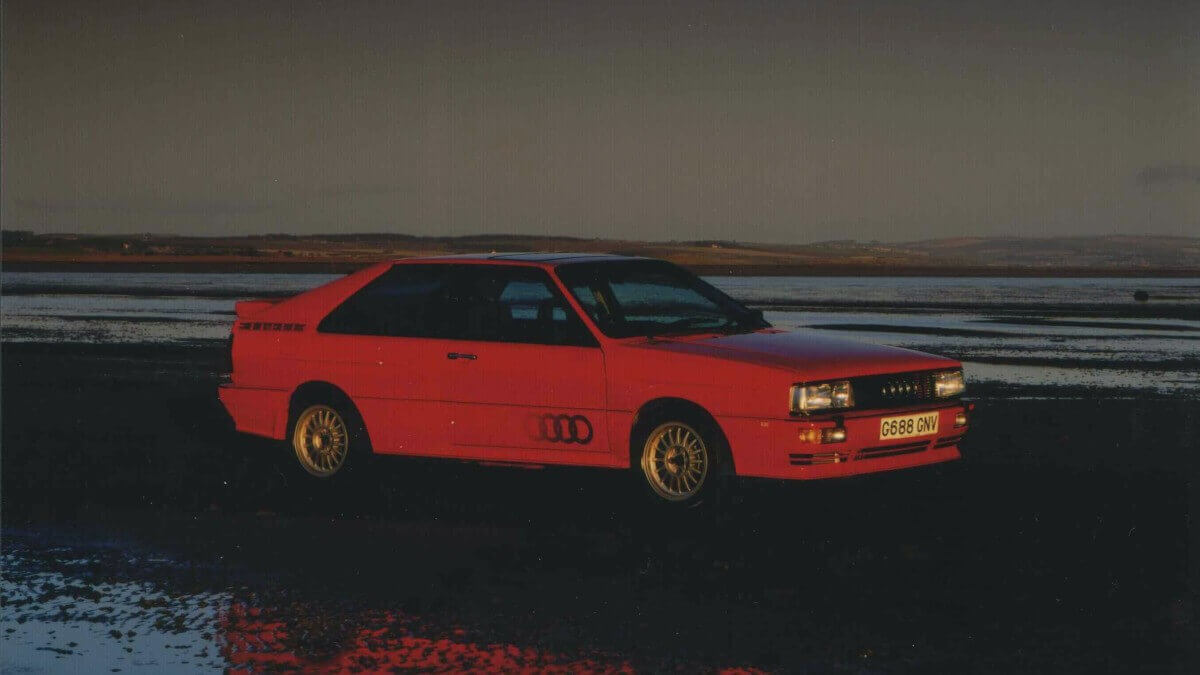



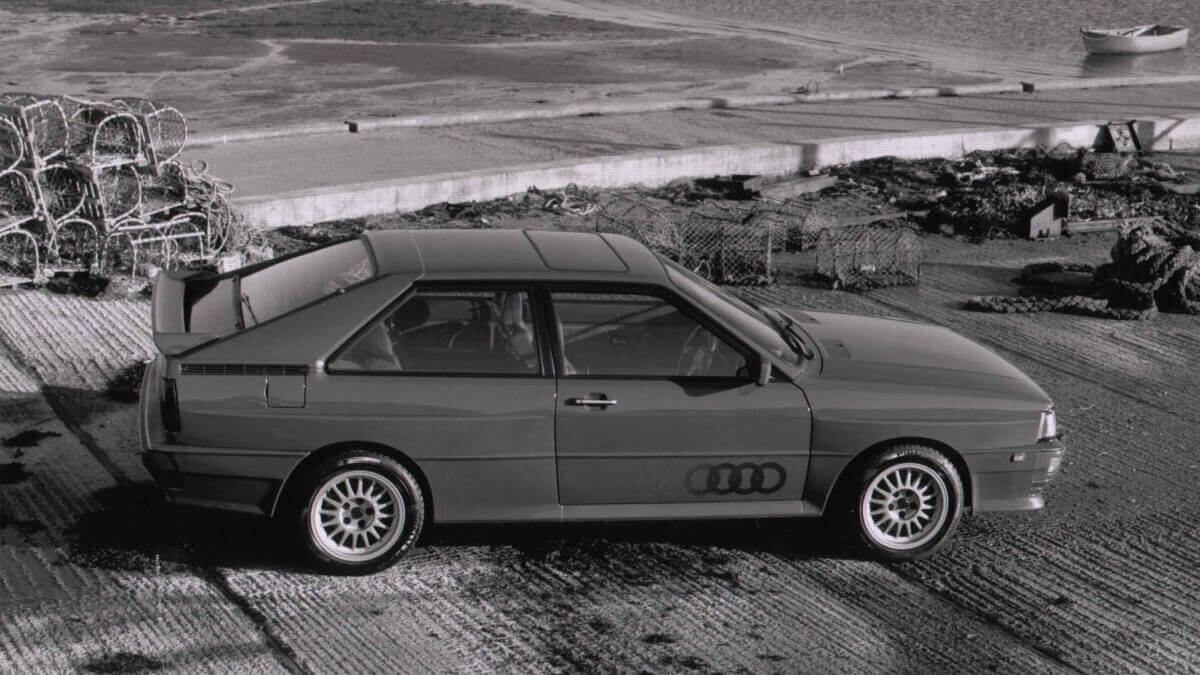



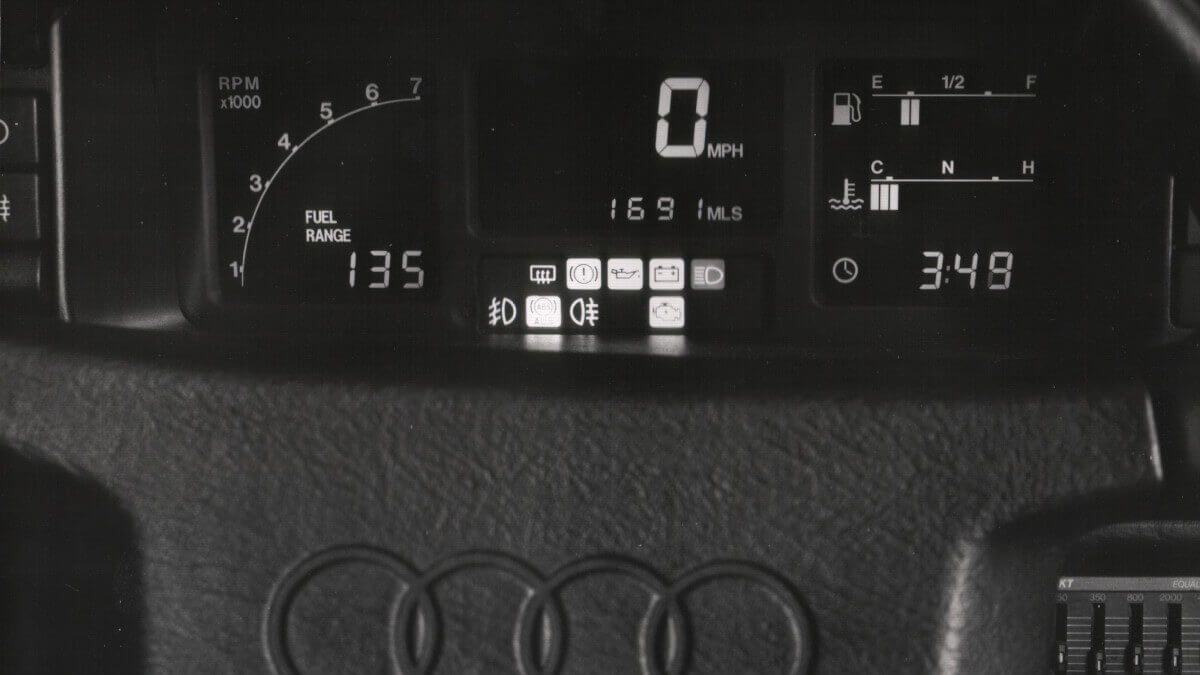



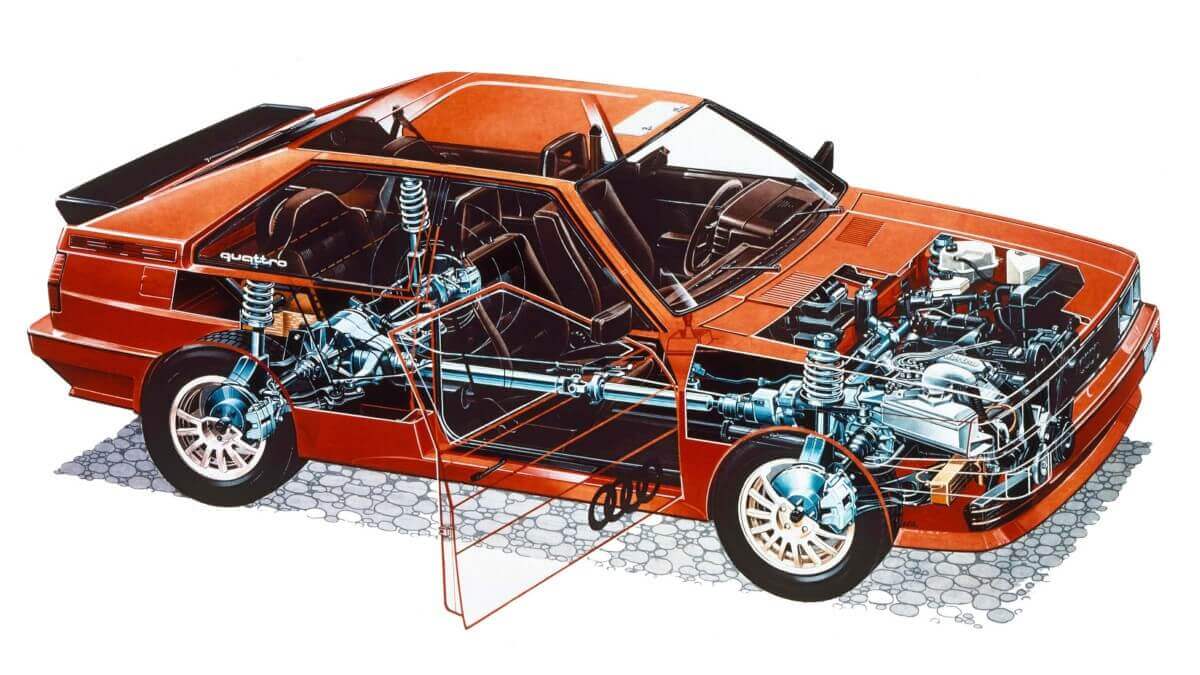



Based on the experience already gained on greasy roads, the decision to go on rally tracks with the quattro was quite obvious. But this wasn’t as easy as it might sound. Although the rally version had been developed parallel to the production car since 1977, four-wheel drive cars weren’t permitted in international rallies until 1979. The intricate paths along which this set of rules was amended is still a little foggy today. At least it is a fact that from the 1980 season onwards, four-wheel drive vehicles were allowed to take on muddy and greasy slopes of the World Rally Championship. While the preparations for rallying were slowly taking shape and even people without rally experience, such as Walter Treser, were being brought into this profession, Audi was able to score points with its driver commitments: Hannu Mikkola from Finland and the French female rally driver Michèle Mouton had signed for the brand from Ingolstadt. The engine output had initially been increased to about 320 hp, while the car’s weight was reduced to 1,180 kilograms.
The first entry of a quattro was only as a pre-rally course car outside of classifications at the 1980 Portugal Rally, as the car hadn’t yet been homologated by the FIA. So this route was chosen in order to be able to collect first test kilometers during a rally and to avoid possible teething troubles of the car. Although the quattro wasn’t entered in the competition, the timekeeping worked perfectly and shook the assembled manufacturers and drivers to the core: If the Audi had officially started, it would have had a 30-minute lead in front of the actual winner. And this, mind you, with even more restrained driving by Hannu Mikkola, since he only sat in the course car. At the first official entry at the Austrian Jänner Rallye in January 1981, Franz Wittmann drove all the national stars of the Alpine state into the ground and even took his time in the last third of the rally to avoid more embarrassment. Nevertheless, a 20-minute lead still remained in the results lists at the finish line. The scent sample of the quattro was out there.
Accordingly, the world’s elite appeared intimidated at the season opener of the World Championship in Monte Carlo. There, however, it became clear that in sport success and defeat do alternate. The fuel tank of the Mouton-quattro had been filled with dirty petrol, which led to towing and a disqualification due to unauthorised assistance. Mikkola beat the competition on the first six special stages and led by more than five minutes before he touched a wall, lost concentration and then crashed the car heavily. Shortly afterwards, however, Mikkola clearly won the Rally Sweden, while in Portugal he retired in the lead after an engine failure. In Corsica both quattros retired, while in Greece they were again leading by more than three minutes, before being disqualified by the rally management due to unauthorised air intakes in the unused inner headlights. The 1000 Lakes Rally in Finland wasn’t under a good star either. Mikkola lost a lot of time during an engine repair and Wittmann, after finishing a special stage, caught a marshal who died of serious injuries shortly afterwards. But the San Remo Rally was the reason for positive headlines: Michèle Mouton became the first woman to win a World Championship rally. So Audi had learned the hard way, and from now on things were to improve. This also included the replacement of Walter Treser at the top of the team by Reinhard Rode and Roland Gumpert, who today is also known for his sports cars from Altenburg.
The following year was soon influenced by the duel between Audi driver Mouton and Walter Röhrl in an Opel Ascona B 400. This car was technically completely outdated, but Röhrl showed that he was undoubtedly one of the best rally drivers of all times. Although he was able to win the Monte, his favourite rally, at the Acropolis Rally in Greece he was literally dismantled by Mouton with a 14 minute lead. Towards the end of the season, things got tighter and tighter until Michèle lost her nerve and threw the quattro into the bushes at the Bandama Rally. Röhrl celebrated his second drivers’ title while Audi clinched the Manufacturers’ Championship. In the meantime, the engine output of the quattro had been increased to about 340 hp and the bodyshell had been put on a diet again. 40 kilograms could be scraped off the sheet metal. A newly designed radiator grille moved into the front, which also took the place of the inner lights of the twin headlights familiar from the production car. At the end of the 1982 season, an aluminium engine block made it possible to save another 25 kilograms in weight and at the same time add 10 hp to the power output.
Again in 1983 Audi wasn’t able to win both titles, which still was the declared goal of the team from Ingolstadt. With the 037 Lancia had created the first true weapon within the Group B regulations. The Italians had also signed two good drivers with Walter Röhrl and Markku Alen, and were able to secure the Manufacturers’ Championship. Although Röhrl, justified by his defeat at the Acropolis in 1982, had said that even a trained monkey could win rallies in an Audi, two years later he himself sat at the wheel of the quattro, which had impressed him very much in the previous years. Shortly before the Rally Monte Carlo started in 1984, Röhrl described himself as a “learner driver” and had Stig Blomqvist teach him how to drive the quattro. He adapted his driving style quickly and beat Blomqvist with ease during the actual event. Stig’s comment: “Röhrl is learning too fast for me!” However, as Röhrl only drove rallies that he enjoyed himself, Blomqvist was already able to follow up with his own victory at the next rally in Sweden. 1984 was also the last year with the ‘long’ quattro. It was crowned by the World Championship title for Stig Blomqvist and the Manufacturers’ title for Audi.
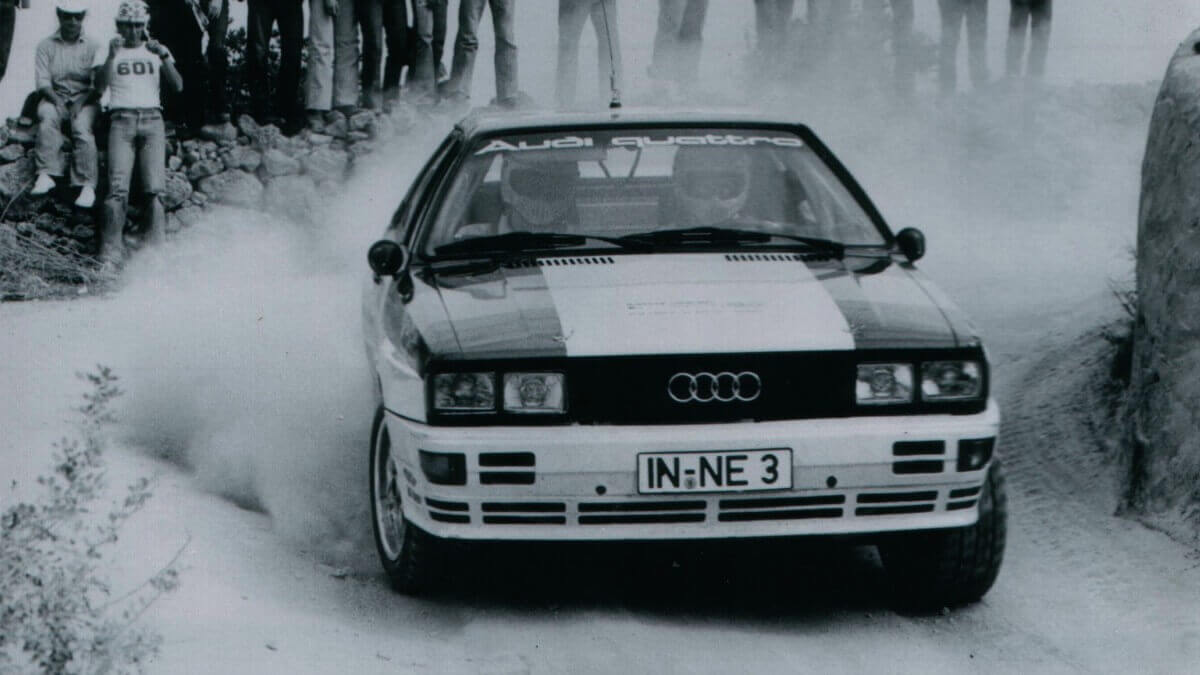



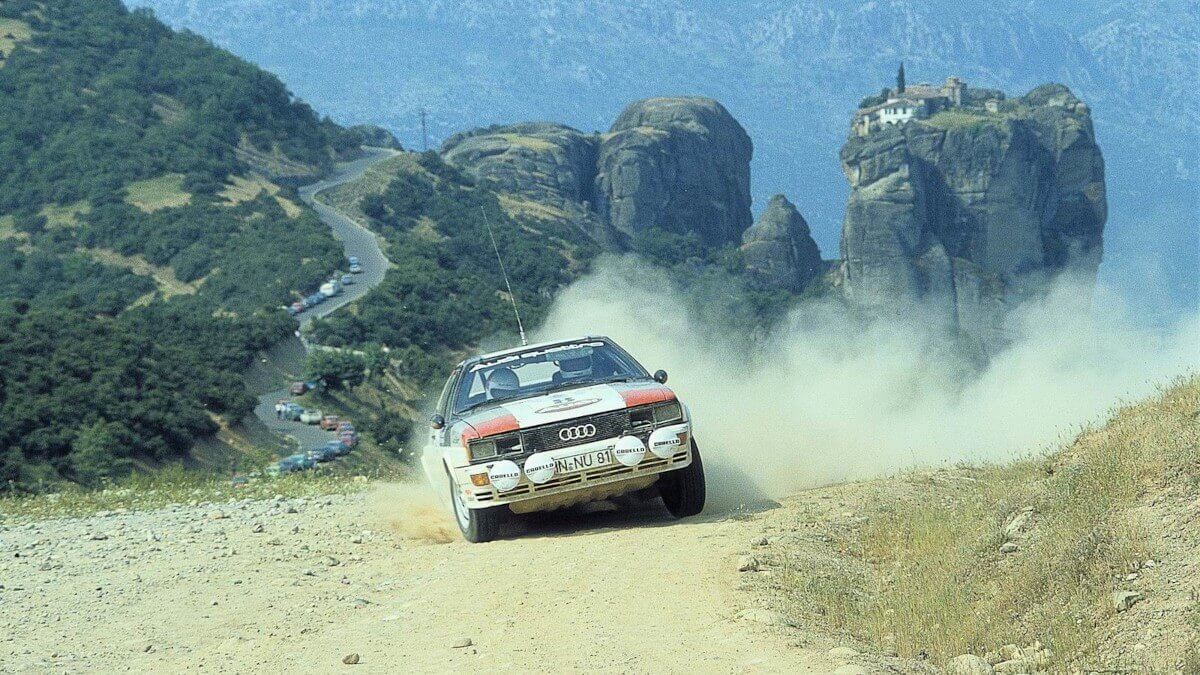



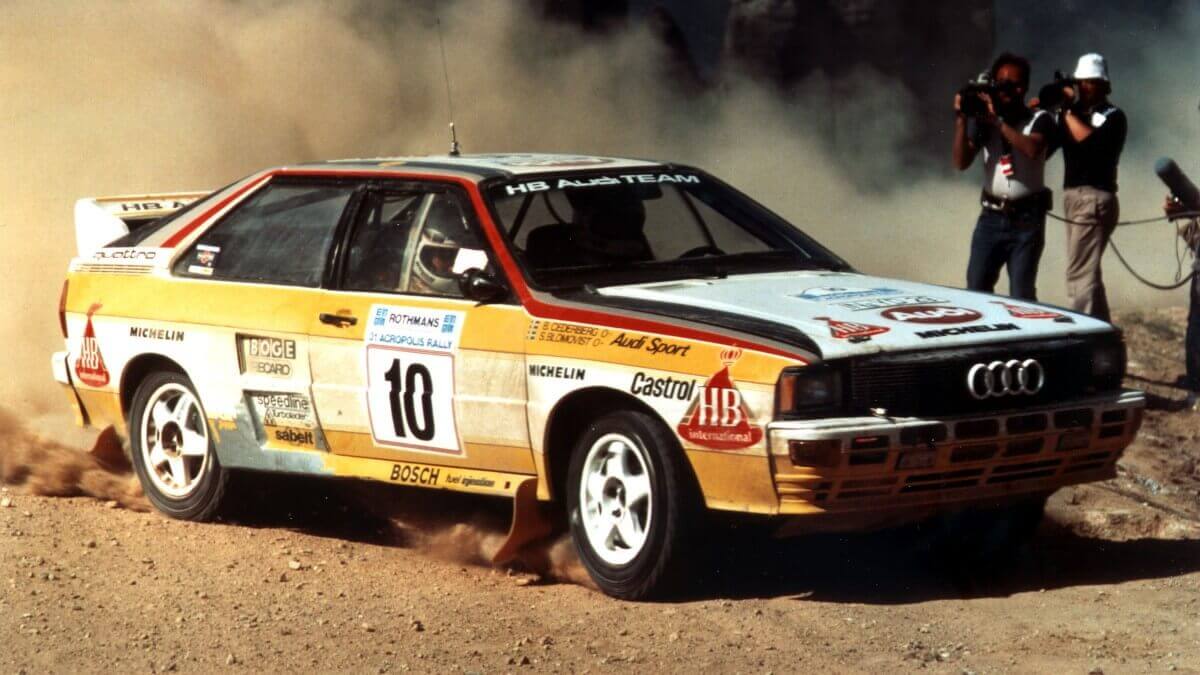



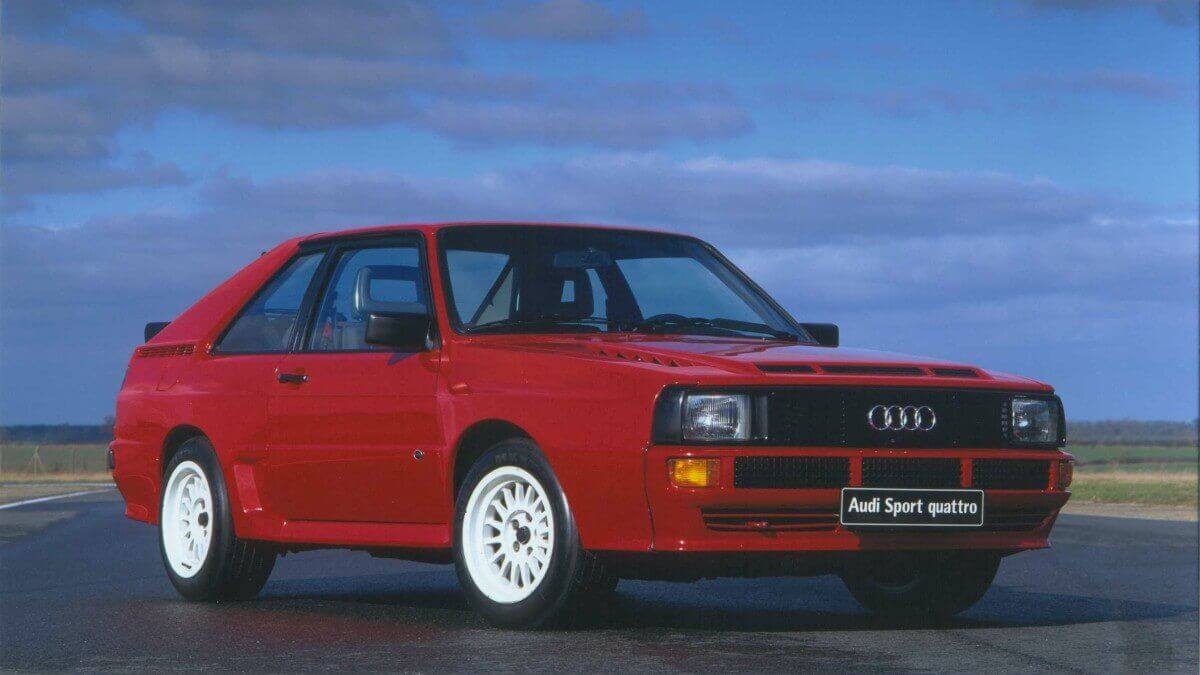



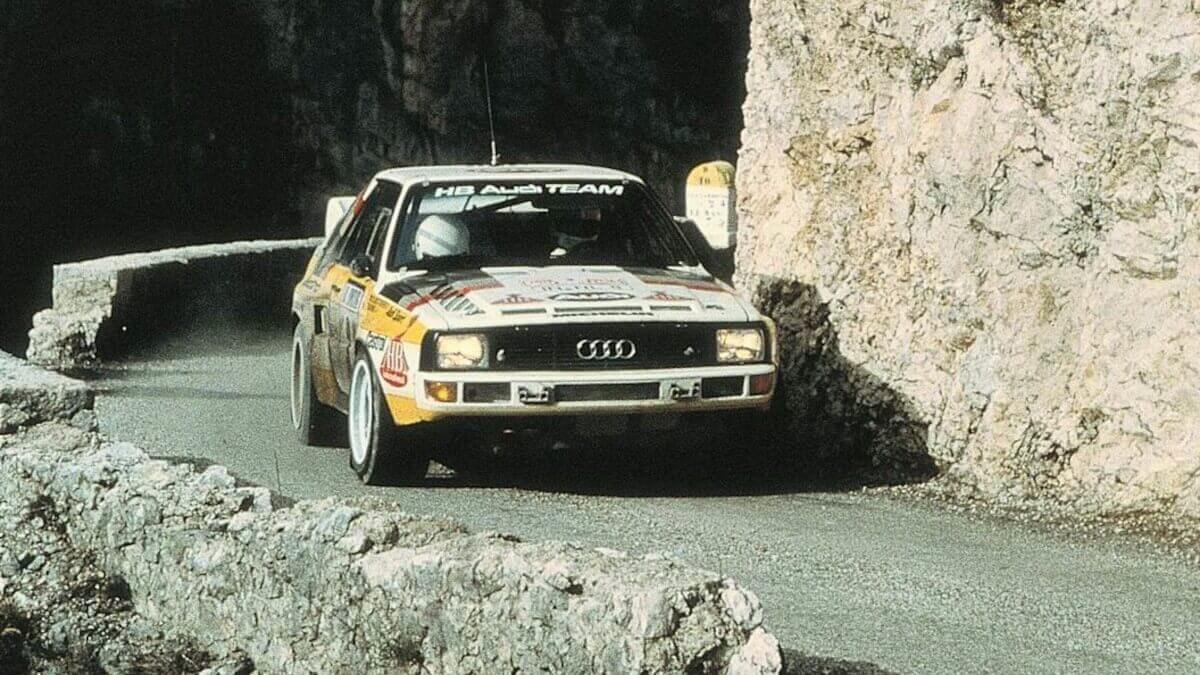



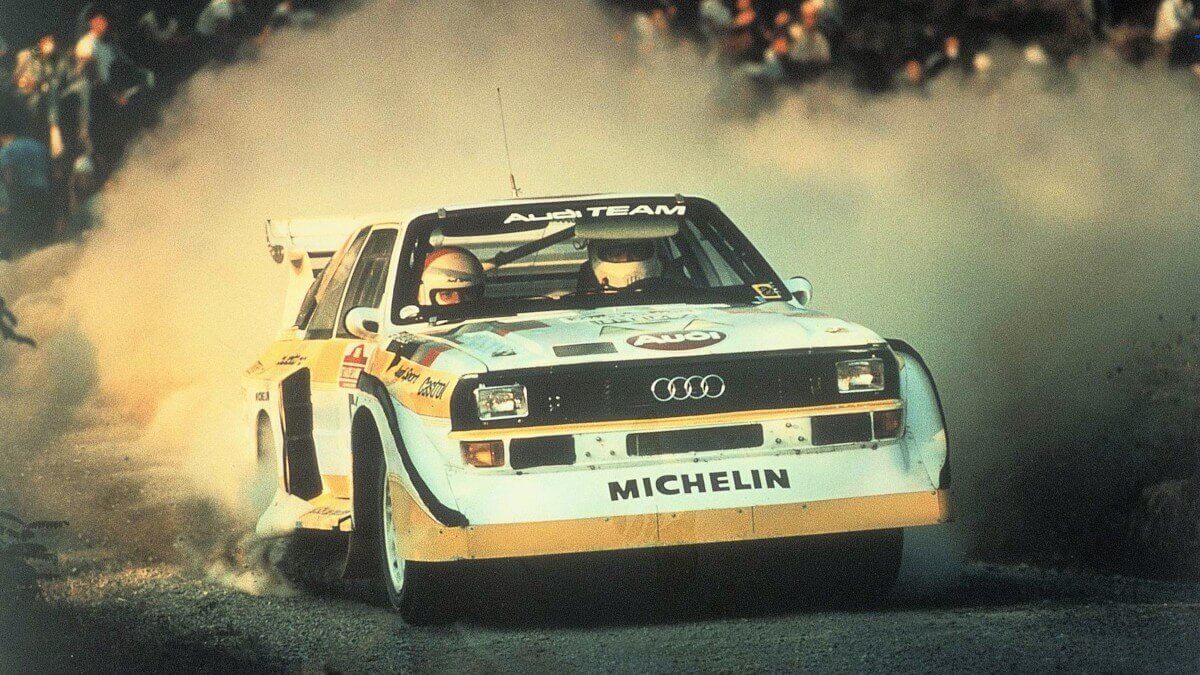



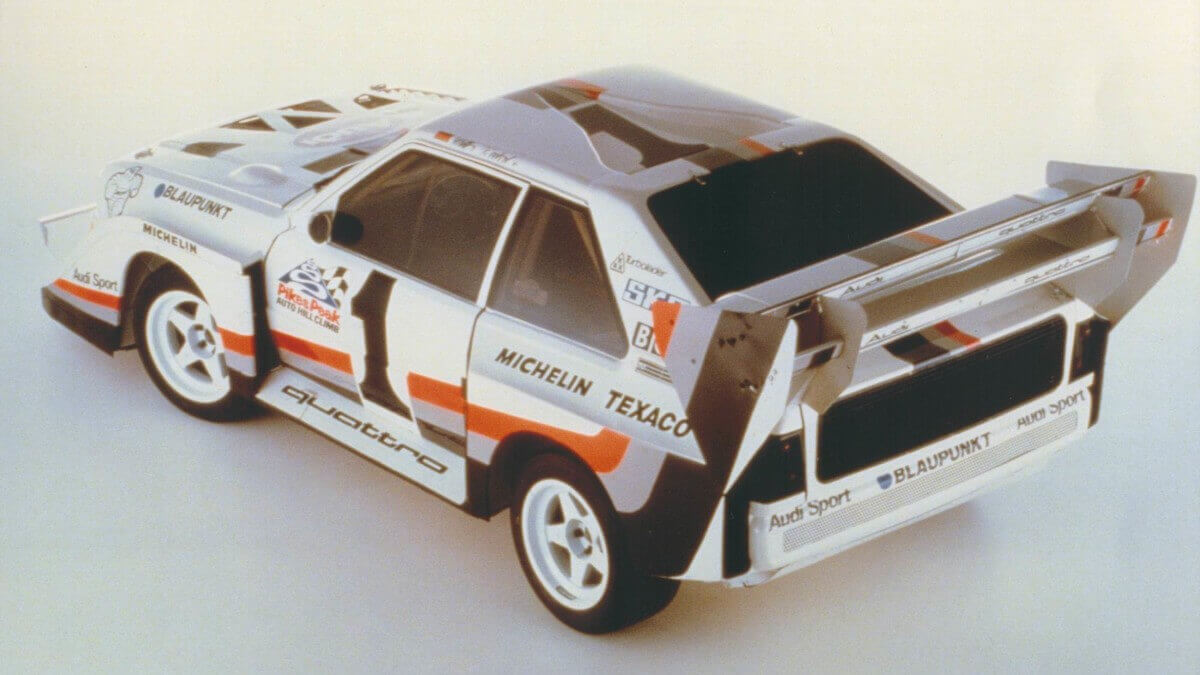



In the meantime, Audi had set about eliminating the quattro’s weak points. The Sport quattro had therefore been conceived. Compared to the well-known quattro coupé, the body between the axles was shortened by 34 centimeters, but the wheelbase was only 32 centimeters shorter, while the five-cylinder engine was increased to 225 kW/306 hp in the road version. The reason for this general rebuild was the competing brands in the World Rally Championship, which were making better and better use of the rather permissive regulations of Group B and scratched the lead of the quattro with vehicles like the Peugeot 205 Turbo 16. This bodywork was carried out by the coachbuilder Baur from Stuttgart, who, after shortening the bodyshell, installed fenders, roof, bonnet and tailgate made of Kevlar, which were supplied by the Swiss specialist Seger + Hoffmann. Together, these parts weighed only 34.2 kilograms and were thus significantly lighter than comparable sheet metal parts.
For the Group B rulebook, Audi had to sell at least 200 vehicles in the road version. In the end, there were even just over 220 in the colors red, dark blue, dark green and white. Two cars were specially ordered in black, otherwise there were no special colors at all, despite or perhaps because of the high sales price of DM 195,000 at the beginning. The last vehicles were finally sold for DM 203,500. That a normal quattro cost only a fraction of that, isn’t worth thinking of. In August 1985 the basic price was DM 77,845. Today, well-preserved Sport quattros cost at least twice what they cost new – except that there is a € sign next to the sum. However, the shortening of the car didn’t bring the hoped-for competitive advantages. Although the weight of the rally car had been reduced to only 960 kilograms and the engine had been increased by another 100 powerful horses (now 450 hp), the design disadvantages of the quattro remained. Since the engine was installed transversely in front of the front axle, the understeering tendency of the vehicle was extremely increased by the shorter wheelbase, whereby under suitable driving conditions it went into oversteering without warning. That led to Röhrl’s verdict: “Undriveable”. So he almost considered it lucky that he retired with engine failure during the first test at the Rally Corsica. Also the following rally events of the ‘short one’ were anything but successful in 1985. Engine and electrical damages reached out to each other. At least at the Ivory Rally, the Sport quattro had held out and with Blomqvist at the wheel could achieve its first victory. It was hoped to drive the bugger out of the car with extensive testing for the following season.
However, the improvements to the handling of the Sport quattro only progressed at a snail’s pace and even the ‘E2’ version (not ‘S1’, as many sources like to claim) brought only little improvement. This car appeared at the Argentina Rally and made it visually clear that Audi wanted to continue to attack and that they had read the Group B regulations quite well. Massive widenings, a large front spoiler, air deflectors on the front fenders and a rear spoiler, which would have been a pleasure for any barkeeper to use as a counter, brought the quattro into completely new optical realms. Add to this the wild turbo-chattering of the now up to 530 hp strong five-cylinder engine and you have the fans still shivering in awe. They tried to the handling under control by shifting the weight. All radiators were moved into the trunk with flow underneath the rear wing, but due to thermal problems this made an additional water sprinkling system necessary. Tanks and pipes, as well as the water itself, added 200 kilograms of additional weight, making the E2/S1 even heavier than the original long quattro rally car.
On the other hand, and absolute novelty was added and tested in the car. On the occasion of the 1985 RAC Rally Great Britain, Audi used a double clutch gearbox developed by Porsche for the first time, with which the car achieved acceleration from 0 to 62 mph in 2.6 seconds – measured on gravel! Further technical innovations for the 1986 season were already in preparation when the FIA banned Group B cars from rallies without replacement due to several serious accidents. Even a mid-engined race car had already been in driving tests and had frightened the local police in the Bavarian Forest. When they saw that local hero Walter Röhrl was behind the steering wheel of this white little monster, the matter was settled with a few autographs. The car can be seen from time to time in the Audi Museum Mobile in Ingolstadt. Since the rally cars of the quattro were no longer of any use on the tracks of the World Rally Championship, the manufacturer looked around for new fields of activity. Some vehicles went into private hands and were used at rally cross events, but the factory itself found a better use for a few cars. In 1985, at the legendary hill climb event at Pikes Peak in the USA, the Sport quattro made its first appearance and won with Michèle Mouton at the wheel in a new overall best time. The following year Bobby Unser won in the E2/S1 with another new best time. With the experience gained, the E2/S1 was then further developed into an absolute wing monster. At the front, an additional wing grew on the spoiler and the already large wing at the rear also grew. In the roof there was a huge hole as air intake for the radiators in the trunk. The engine now produced 600 hp (officially), maybe more. With Walter Röhrl behind the wheel, the track record for the 20 kilometers long course with 156 corners was lowered under 11 minutes for the first time – to 10:47.85 minutes to be exact. Although this record only lasted for one year until Peugeot broke it, the hoped-for advertising effect in the USA was achieved.
Images: Audi Tradition, Audi UK




